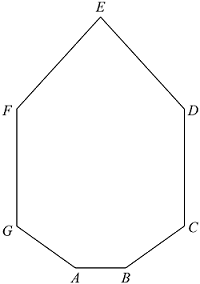SAT Polygons

A diagonal in a polygon is defined as a segment connecting two non-adjacent vertices. How many diagonals does the figure above have?
(A)
1
4
(B)
1
6
(C)
1
7
(D)
1
8
(E)
2
8
This section requires Javascript.
You are seeing this because something didn't load right. We suggest you, (a) try
refreshing the page, (b) enabling javascript if it is disabled on your browser and,
finally, (c)
loading the
non-javascript version of this page
. We're sorry about the hassle.
2 solutions
Nice solution. In general, for an n -sided convex polygon the number of diagonals D n will be the number of combinations of 2 vertices chosen from n vertices, minus the number of sides of the polygon, (as these are not considered as diagonals). Thus
D n = ( 2 n ) − n = 2 n ( n − 1 ) − n = 2 n ( n − 3 ) .
So in this case D 7 = 2 7 ( 7 − 3 ) = 1 4 .
n*(n-3)/2 where n is side of the polygon So 7(7-3)/2= 14 that'll !! Simple :-)
derivation of that formula comes from combinatorics... Brian has given the whole thing before you!
Log in to reply
You are right Mrs. Sarthak!!! Mr. Brian u are great!!! :-)
Correct Answer: A
Solution 1:
Tip: Draw a picture.
We draw all of the diagonals and count them, making sure not to repeat or miss any of them. We count 14 diagonals. These are shown below.
Solution 2:
Because sides of the polygon do not count as diagonals, from each vertex we can draw 7 − 3 = 4 diagonals. The diagonals for vertex A are shown below.
There are 7 vertices in total. So, there are 7 ⋅ 4 = 2 8 diagonals that can be drawn, four from each vertex.
But, because we are counting each diagonal twice -- A F is drawn from vertex A to vertex F and F A is drawn from vertex F to vertex A -- we must divide our result by 2.
So, in a heptagon, there are 2 8 : 2 = 1 4 diagonals.
Incorrect Choices:
(B) , (C) , and (D)
If you miscount, you may get one of these wrong choices.
(E)
If you count each diagonal twice, you will get this wrong answer.